How to connect Windows Server 2008 and Windows Vista to iSCSI server (Part 1)
David Davis
What is iSCSI?
iSCSI is a protocol that allows two hosts to send SCSI commands over a TCP / IP network. By doing this, you can still use SCSI but free yourself from the limitations of connecting a traditional SCSI cable instead of using a LAN to connect your SCSI computers and servers to the zone. SCSI storage area.
iSCSI is a storage area network (SAN) type and is typically compared with Fiber Channel (FC) - its much more expensive competitor.
With iSCSI, you have a client. This client uses the initialization software to connect to the storage server (called a target). While the iSCSI client software initializer is available in Windows Vista and Windows Server 2008, the iSCSI target (server) still has a very high cost.
How to create a free iSCSI storage target server
Maybe you already have a hardware iSCSI server. If so, what a great thing! However, in the absence of this you should consider OpenFiler. OpenFiler is an open source iSCSI target server that can run on computers or server systems. This is a changed Linux kernel with GUI front-end interface. You don't need to worry if you don't know Linux. With OpenFiler, you never have to use the Linux command line utility.
Like other storage servers, OpenFiler can convert regular disks into RAID disks and provides many sharing options besides iSCSI, such as SMB, FTP, HTTP and NFS.
With this simple software you can create an iSCSI target server for your Windows Server 2008 and Windows Vista systems to be accessible.
To get OpenFiler, go to the OpenFiler site to download 370MB ISO. This ISO is the OpenFiler installer. All you need to do here is insert the disc into the system. When booting from CD, you must press Enter to install OpenFiler. This installation process is very simple, just click Next three times, Yes twice, . configure static IP address on OpenFiler ( recommended not required ), change zone time, set root password Next, click Next, restart the server and the installation is complete.
Although this article introduces connecting the Windows servers to the iSCSI target server, not talking about how to manage or configure this server, but we will show you a little more about how to configure it. OpenFiler.
How to configure OpenFiler to allow access to iSCSI clients
These are the basics of configuring OpenFiler to allow access to iSCSI clients:
- Log in to the Admin interface by going to https: // xxxx: 446
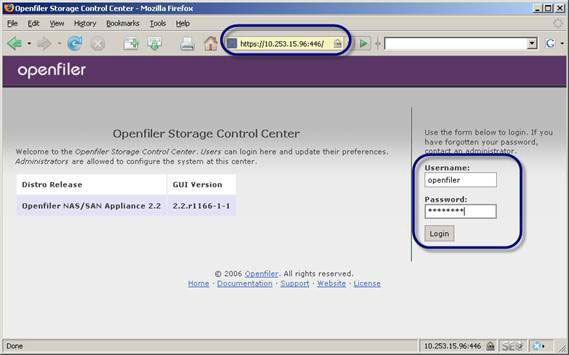
Figure 1: OpenFiler administrator login interface
- The default username and password are openfiler and password
- Go to the services and activate the iSCSI Target service
- Go to Volumes , then Physical Storage Management , click on the name of the drive, this is where you want to create a new partition (we did the second drive in the server next to the boot disk). In our case, click / dev / sdb
- Create a partition on that disk
- Now go to Volume Group Management , name the new VG, check the Select checkbox and click Add volume group.
- Now click Create new Volume . Create an iSCSI file system partition in VG with the size you want.
- Go to the General tab and add your local network to the networks tab. This works the same in the same network that the Win 2008 Server or Vista servers are located in.
- Returning to the Volume properties, edit it a little, change the internal network to Allow instead of the default block. Click Update.
- Now disable and enable iSCSI service.
Get the IP address of the OpenFiler iSCSI server, and you are now ready to access from Windows Server 2008 or Windows Vista systems.
How to connect Windows Vista to iSCSI SAN
To connect Windows Vista to the iSCSI target, you need to go to Control Panel, double-click the iSCSI Initiator initializer.
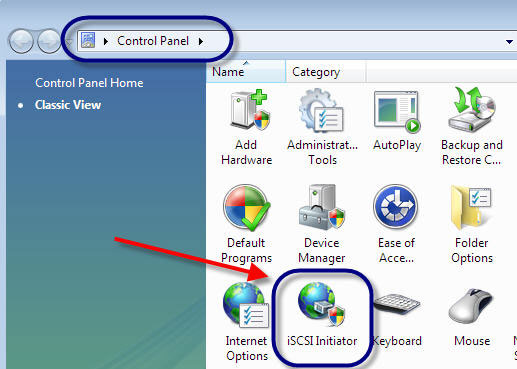
Figure 2: Vista's iSCSI Initiator - Control Panel initializer
When you see the dialog box below, answer Yes to start the iSCSI service each time the system boots up later.
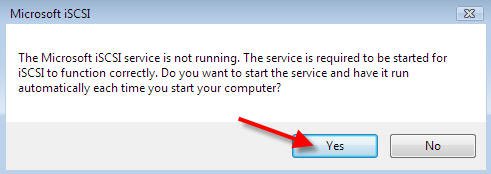
Figure 3: Vista - start the iSCSI auto initializer
When you see the dialog box below, answer Yes to unlock the iSCSI service for the Windows firewall.
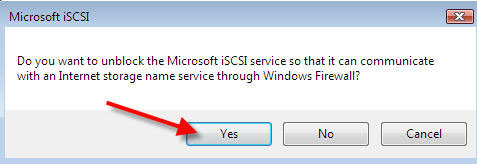
Figure 4: Vista - allows iSCSI to pass through the firewall
When the iSCSI Initiator Properties appears, click the Discovery tab. Click Add Portal .
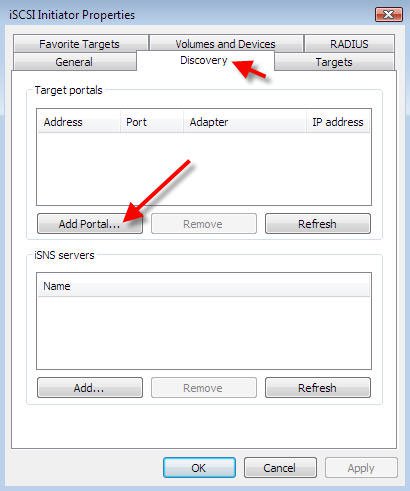
Figure 5: Vista - Add the iSCSI Portal
Enter the IP address or DNS name of the iSCSI server when the Add Target Portal window appears as follows:

Figure 6: Vista - iSCSI is adding Target Portal
(port number 3260 is already here since this is the default iSCSI port number)
Click OK .
Go to the Targets tab and click Refresh . You will see the name of iSCSI Target in the list.
Select your target server and click Log on .
Click the Automatically check the option to connect this connection when the computer starts and click OK .
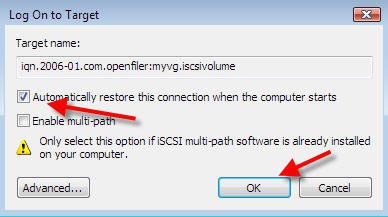
Figure 7: Log in to iSCSI Target
At this point you will see your status is Connected
Click OK and close the iSCSI Initiator Properties.
Click Administrative Tools , open Computer Management and click Storage -> Disk Management .
You will have to initialize the disk if not previously used.
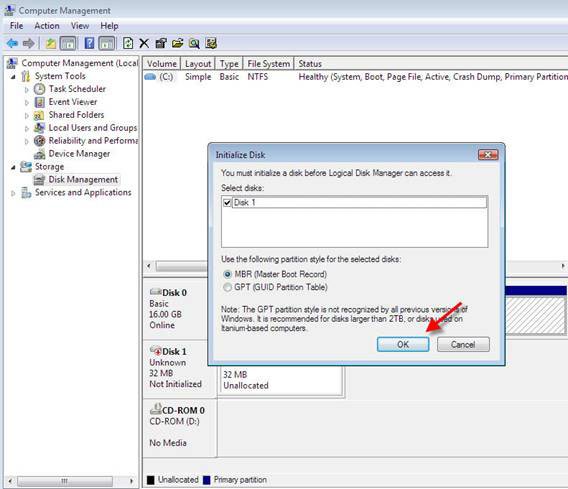
Figure 8: Vista's Disk Manager 1
You should now see the new drive in Disk Manager. In our case, you will see Disk 1 / Basic / 32MB / Online as shown in the image above.
(We created a disk size of 32MB for demonstration purposes only)
Right-click the disk and click New Simple Volume.
Take turns through the steps to format and assign drive letters.
When you're done, your disk manager will look like the following:
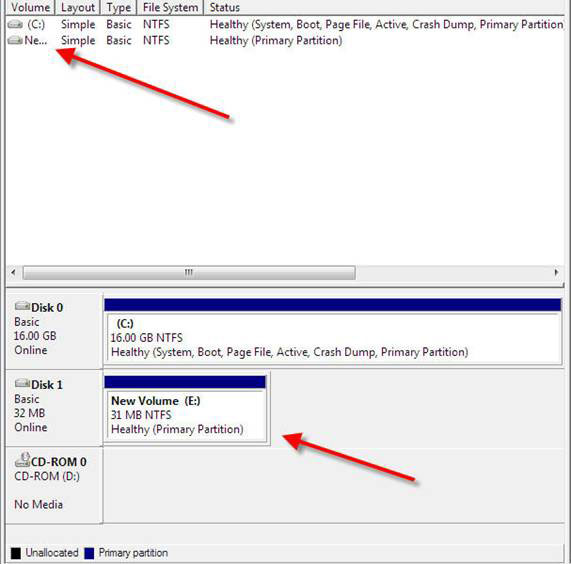
Figure 9: Vista's Disk Manager 2
You can access the shared iSCSI disk in My Computer as a regular drive letter, like this:
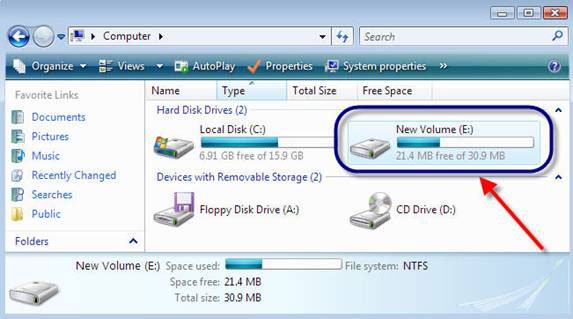
Figure 10: Observe the new iSCSI partition in My Computer
To test, we tried a file on the new iSCSI E drive.
When our Vista iSCSI connection is complete, switch to Windows Server 2008.
Connect Windows 2008 Server with iSCSI Target
Next and like Windows Vista, to connect to Windows Server 2008 with the iSCSI target, you must go to the Control Panel and double-click the iSCSI Initiator initializer.
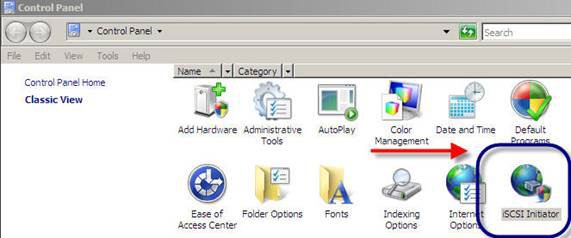
Figure 11: Windows Server 2008 - Launch iSCSI Initiator in Control Panel
Next you will be prompted to see if you want the iSCSI Service to start automatically. We have selected Yes in this case.
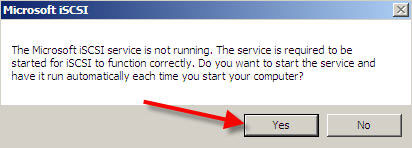
Figure 12: Windows Server 2008 - Launch iSCSI Initiator whenever Win 2008 starts
After clicking Yes, iSCSI is also enabled through the Windows Server 2008 firewall
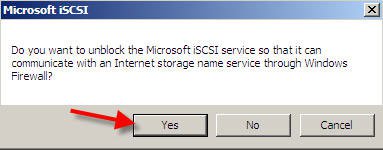
Figure 13: Windows Server 2008 - Allow iSCSI via Firewall
(The steps below are where you configure the iSCSI Initiator just like in Windows Vista).
- When the iSCSI Initiator Properties appears, click the Discovery tab and click Add Portal .
- Enter the IP address or domain name of the iSCSI server when the Add Target Portal window appears and click OK .
- Go to the Targets tab and click Refresh . You will see the name of your iSCSI Target in the list.
- Select your target server and click Log on .
- Check the Automatically restore this connection when the computer starts option and click OK .
- You should see your connected status now.
- Click OK and close the iSCSI Initiator Properties.
Because in our case, this iSCSI partition was initialized on a Windows Vista computer, we don't need to go into Disk Manager. However, if this is a new partition that has not yet been connected to another Windows computer, you need to use Windows Server 2008's Disk Manager to initialize the partition, format and assign the drive letter to it. .
When all these procedures are done, go to My computer and you can see this new disk partition.
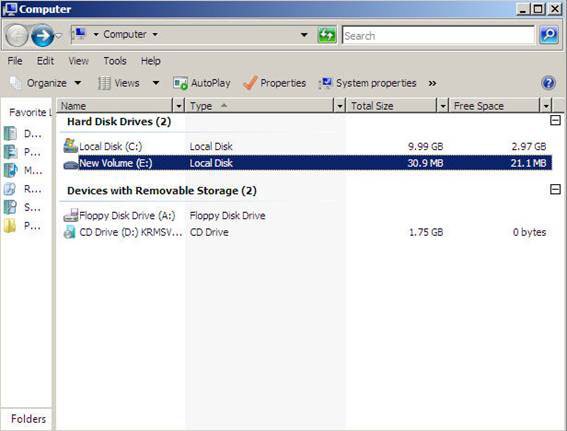
Figure 14: Windows Server 2008 - view the shared iSCSI partition
In fact, if you open this drive, you will see the file name we copied to the iSCSI shared partition from your Windows Vista computer (below).

Figure 15: Windows Server 2008 - view shared iSCSI partitions and shared files
Conclude
ISCSI SAN technology is becoming more and more popular today. The ability to connect Windows Vista and Windows Server 2008 to iSCSI SAN is an extremely important skill for system administrators. Knowing how to set up iSCSI host will give you a lot of flexibility!
You should read it
- How to install iSCSI Target on Windows Server 2019
- Deploy Exchange Server 2007 Service Pack 1
- Using Windows Server 2008 system like Router NAT
- Check Server 2008 operating time
- Fix the problem when removing Windows Server 2008 Server Core from the domain
- Steps to prepare for installing Windows Server 2008
- Diskperf command in Windows
- Connect Windows 7 to the iSCSI SAN server
May be interested
- Use Web browser to connect FTP Server
 there are many ways to connect to the ftp server and access the content in it. however, the simplest way is to use internet explorer. the ftp connection method via internet explorer is used in case you only want to download or view files stored on ftp public server (with incognito mode).
there are many ways to connect to the ftp server and access the content in it. however, the simplest way is to use internet explorer. the ftp connection method via internet explorer is used in case you only want to download or view files stored on ftp public server (with incognito mode). - How to connect to an FTP Server from Windows Explorer?
 windows allows users to easily connect to an ftp server and the shared ftp folder using add network location wizard. after running the wizard, you can easily manage (copy, move, delete, create or rename ...) all content on ftp server from windows explorer.
windows allows users to easily connect to an ftp server and the shared ftp folder using add network location wizard. after running the wizard, you can easily manage (copy, move, delete, create or rename ...) all content on ftp server from windows explorer. - Using Windows Server 2008 system like Router NAT
 in this article we will install a test network using a dsl router to connect to the internet.
in this article we will install a test network using a dsl router to connect to the internet. - Connect Windows 7, Vista and Windows XP computers
 in this article, i will show you how to connect to the network between different versions of windows operating systems.
in this article, i will show you how to connect to the network between different versions of windows operating systems. - Guide to controlling device security built-in in Windows (Part 1)
 in this two-part article we will show you how to protect windows xp, windows server 2003 or windows vista from unwanted or pre-installed devices such as usb flash drives. , ipod, cd-rom, dvd, wireless interface & he
in this two-part article we will show you how to protect windows xp, windows server 2003 or windows vista from unwanted or pre-installed devices such as usb flash drives. , ipod, cd-rom, dvd, wireless interface & he - Fix the problem when removing Windows Server 2008 Server Core from the domain
 in the following article, we will show you how to handle and fix errors when removing windows server 2008 r2 server core from the domain system. the case here is that both core and domain controller (dc) systems are virtual machines, when the user tries to switch dc to the state of the previous snapshot, but the core part cannot access the data source on the dc. ...
in the following article, we will show you how to handle and fix errors when removing windows server 2008 r2 server core from the domain system. the case here is that both core and domain controller (dc) systems are virtual machines, when the user tries to switch dc to the state of the previous snapshot, but the core part cannot access the data source on the dc. ... - Fix error Can't Connect to Proxy Server on Windows 10
 sometimes in some cases when using a windows 10 computer to access a web page on the browser, users often encounter errors cannot connect to the proxy server. so how to fix this error and connect to the web site you want to access.
sometimes in some cases when using a windows 10 computer to access a web page on the browser, users often encounter errors cannot connect to the proxy server. so how to fix this error and connect to the web site you want to access. - Hide data into a secure location - Part 2: Vista
 in the previous article of this series, i showed you how to do it with the xp operating system, in this second part, we will cover how to do it in windows vista.
in the previous article of this series, i showed you how to do it with the xp operating system, in this second part, we will cover how to do it in windows vista. - Deny access when managing Hyper-V remote server in Workgroup
 typically, when people use the hyper-v management tool on windows vista or windows 7 operating systems, then connect to the remote-controlled windows server 2008 r2 installation computer with the hyper-v role activated, and in case both computers are in workgroup, the system will display the following error ...
typically, when people use the hyper-v management tool on windows vista or windows 7 operating systems, then connect to the remote-controlled windows server 2008 r2 installation computer with the hyper-v role activated, and in case both computers are in workgroup, the system will display the following error ... - Deploy Exchange Server 2007 Service Pack 1
 exchange 2007 supports new generation windows operating systems including windows server 2008 and windows vista (for management purposes). for windows 2008 and windows vista users or administrators, we must install using the latest media with rtm version and
exchange 2007 supports new generation windows operating systems including windows server 2008 and windows vista (for management purposes). for windows 2008 and windows vista users or administrators, we must install using the latest media with rtm version and










 Adjust bandwidth saving via QoS (Part 2)
Adjust bandwidth saving via QoS (Part 2) Secure the internal admin group on the desktop
Secure the internal admin group on the desktop Adjust bandwidth saving via QoS (Part 3)
Adjust bandwidth saving via QoS (Part 3) Select network device hardware
Select network device hardware Select network device hardware (Part 2)
Select network device hardware (Part 2) Select network device hardware (Part 3)
Select network device hardware (Part 3)